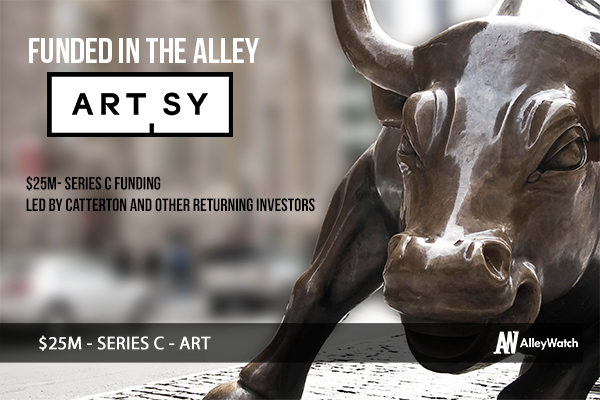Talk about a lot of talent all in one place, Artsy is on a mission is to make all the world’s art accessible to anyone with an internet connection, and that includes anyone with an iPhone as well (are iPhone owners artsier?).
“There is a significant opportunity to expand the global art market, and we believe Artsy can do so as consumer purchasing preferences are rapidly moving online,” says Carter Cleveland, founder and CEO of Artsy.
Artsy first launched in 2009, which were the relatively early days of the online industry’s resurgence in NYC, and they’ve been growing and innovating ever since.
Michelle Finocchi, Artsy’s Head of Communications, and Director of Media and Brand Partnerships, talks about the funding, and the plans going forward from a company that, so far, has made all the right moves..
Who were your investors and how much did you raise?
We raised a $25M – Series C, led by Catterton. Returning investors in the round include Thrive Capital, IDG Capital Partners and the Rockefeller family.
Tell us about your service.
Artsy is the leading resource for learning about and collecting art from over 3,000 leading galleries, 425 museum and institutional partners, and over 50 select art fairs and auctions. Artsy provides free access via its website (Artsy.net) and iPhone app to 250,000 images of art and architecture by 40,000 artists, which includes the world’s largest online database of contemporary art. Artsy’s encyclopedic database spans historical works, such as the Rosetta Stone and the Colosseum, to modern and contemporary works by artists such as Pablo Picasso, Willem de Kooning, Richard Serra, Lucien Smith, Sarah Lucas, and Cindy Sherman. Powered by The Art Genome Project, a classification system that maps the connections between artists and artworks, Artsy fosters new generations of art lovers, museumgoers, patrons, and collectors.
What inspired you to start the company?
Our founder, Carter Cleveland, started Artsy in his dorm room at Princeton. His father is an art writer and a collector, and Carter grew up learning about art, going to galleries and museums, and also living with art. In college, he was surprised to find that there wasn’t a website with all of the world’s art on it, as there were for music and film. He was inspired to create a website where anyone could learn about art and also collect art.
How is it different?
Artsy is different from other online art companies in a few ways.
Artsy offers a unique experience: a comprehensive resource for learning about and collecting art. No ones else provides access to every aspect of the art world–museums, galleries, foundations, artist estates, image archives, art fairs, and auctions–all in one place.
Other online companies sell art, but many differ from Artsy in that they are taking on selling artwork themselves. In contrast, Artsy partners with the industry players (galleries, art fairs, and auctions) to connect them with a global audience of collectors. Other online art sites also lack comprehensiveness and educational context.
Another thing that makes Artsy unique in the online art world is our focus on premium technology, and our commitment to building a digital platform worthy of fine art. Artsy invests in technology online and offline to expand access to art and to make physical experiences such as visiting an art fair more informative and engaging. (Download the Artsy iPhone app, your personalized mobile guide to The Armory Show, and see our Artsy Columns, navigational beacons positioned around the fair.) Another example of Artsy’s commitment to technology is the emphasis it places on contributing to the open source community.
What market you are targeting and how big is it?
Everyone around the world with an internet connection who is interested in art, in any capacity. This includes students, educations, art lovers, patrons, and collectors.
What’s your business model?
Galleries pay monthly subscription fees to list works for sale on Artsy.
For auctions we host on Artsy, we receive a commission.
What factors about your business led your investors to write the check?
One factor is Artsy’scontinued growth.
In the past year, the number of galleries listing for-sale artworks on Artsy, and revenue from gallery subscriptions has tripled. Between 2013 and 2014, the total estimated value of new gallery inventory on Artsygrew by 89%. To date, collectors have inquired on an estimated $10.2 billion worth of art on Artsy.
Where do you see the company going now over the near term?
We’ll continue to expand our gallery subscription business and also our educational database from museums and non-profit partners. Additionally, we’ll be working to scale our international expansion efforts particularly in China, which we consider to be a big opportunity for the business.
What’s your favorite artsy hang-out spot in New York?
Artsy Happy Hour! Every Friday we invite our friends from art and tech over for drinks.




